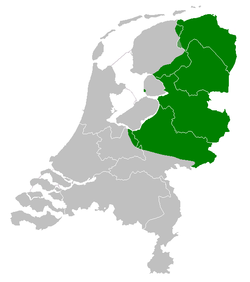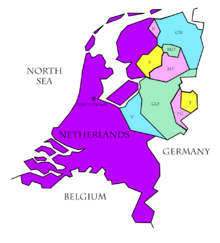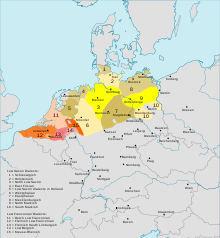- Dutch Low Saxon
-
This article is a part of a series on Dutch dialects "Dutch Low Saxon" - Tweants
- Gronings
West Low Franconian East Low Franconian - Limburgian
- Southeast Limburgian
(including
Aachen dialect /
Eschweiler dialect) - Low Dietsch
Low German West Low German dialects spoken in the northeastern Netherlands. In comparison, the remainder of the Netherlands (besides the Frisian speaking part) speak a collection of Low Franconian dialects. The class "Dutch Low Saxon" is not unanimous. From a diachronic point of view, the Dutch Low Saxon dialects are merely the Low Saxon dialects which are native to areas in the Netherlands (as opposed to areas in northern Germany). From a strictly synchronic point of view, however, some linguists classify Dutch Low Saxon as a variety of Dutch.[1] Some Dutch Low Saxon dialects show features of Westphalian, a West Low German dialect spoken in Germany.
Dialects
Language classification Indo-European languages Germanic languages West Germanic languages Low German Dutch Low Saxon Dutch Low Saxon comprises the following forms (any of which are considered separate languages in ISO 639-3):
- Westerkertiers
- Pompsters
- Kölmerlands
- Middaglands
- Midden-Westerkertiers
- Zuud-Westerkertiers
- Grunnegs and Noord-Drèents
- Hoogelaandsters
- Stadsgrunnegs
- Westerwoolds
- Veenkelonioals
- Oldambtsters
- Stellingwarfs
- Midden-Drèents
- Zuud-Drèents
- Tweants
- Tweants-Groafschops
- Gelders-Oaveriessels
- Achterhooks
- Sallaans
- Urkers
- Veluws
- Oost-Veluws
- West-Veluws
Most varieties belong to the West Low Saxon group. Grunnegs is so different from the rest of the Dutch Low Saxon varieties that it may be treated separately. Tweants and Achterhooks belong to the Westphalian group of dialects. The remainder, Drèents, Stellingwarfs, Sallaans, Urkers and Veluws, could be classified in their own subdivision, since they form the westernmost group of Low Saxon dialects, considerably affected by Dutch. Urkers and West-Veluws are even so heavily Hollandified that some people classify these dialects as Low Franconian rather than Low Saxon.
Dutch influence
A lot of these dialects have been affected by the Hollandic expansion of the seventeenth century. All of them are lexically dependent on Dutch rather than German for neologisms. When written down, they use a Dutch-based orthography.
- a unified plural in -en rather than -t
- This is found in West-Veluws and Urkers and clearly ensued from Dutch influence, since a unified plural in -t for verbs is common in Low Saxon. These dialects have wiej warken instead of wiej warkt for "we work". This feature is, surprisingly, also found in Stellingwarfs and Grunnegs, but here this trait is believed to have Frisian rather than Hollandic origins (the Stellingwerven have been Frisian for centuries and Groningen was a Frisian speaking area in the Middle Ages). Modern Frisian has -e here, -en may be a kind of intermediate form between -t and -e. This unified plural takes the form -et rather than -t in the Achterhooks dialect of Winterswijk.
- several long vowel shifts
- Veluws, Sallaans, Stellingwarfs and Drèents have experienced mutation as the Hollandic dialect rose in prestige during the seventeenth century. The ee [eː] mutated into ie [iː], the oo [oː] into oe [uː] and the oe [uː] into uu [yː]. Tweants and Eastern Achterhooks, by contrast retained their old vowels. Compare these Tweants and Sallaans couples: deer - dier ("animal"); good - goed ("good"); hoes - huus ("house"). Surprisingly, in many dialects the oe sound was preserved in some words while it mutated towards uu in others. As a result, in Sallaans "huis" (house) translates as huus but "muis" (mouse) as moes (as in Tweants).
- loss of the word du "thou"
- Dutch has lost the word doe "thou" and replaced it with jij, "ye", originally the second person plural. In many Low Saxon dialects in the Netherlands, the very same happened. The doe - ie/ieje/ij isogloss runs surprisingly close to the Dutch border, except in Groningen, where it enters the Dutch territory with a vengeance (in the entire province this word is known). In Twente, it is present in the easternmost villages of Denekamp and Oldenzaal, in de Achterhoek (Gelderland), dou is present in Winterswijk and Groenlo.
References
- ^ Hermann Niebaum/Jürgen Macha: Einführung in die Dialektologie des Deutschen, 2., neubearbeitete Auflage, Tübingen: Max Niemeyer, 2006, p. 221, footnote 7.
v · d · eModern Germanic languages and dialects North Germanic West ScandinavianEast ScandinavianWest Germanic Low German/
Dutch Low SaxonAchterhooks • Drèents • East Frisian Low Saxon • Gronings • Low German • Plautdietsch • Sallaans • Stellingwarfs • Tweants • Veluws • WestphalianAlemán Coloniero • Alsatian • Austro-Bavarian • Main-Franconian • Cimbrian • Hutterite German • Mócheno • Swabian • Swiss German • Walser
Wikimedia Foundation. 2010.
Look at other dictionaries:
Dutch Low Saxon Wikipedia — URL nds nl.wikipedia.org Commercial? No Type of site Internet encyclopedia project … Wikipedia
Dutch Low Saxon — noun A non standardized cluster of regional dialects of Low Saxon, influenced by Dutch, spoken in the northeastern provinces of the Netherlands, and recognized as a minority language by the European Union … Wiktionary
Low Saxon — may refer to:*Of or relating to Lower Saxony *Any West Low German speech variety *The Northern Low Saxon speech varieties *Especially in the Netherlands, any Low German speech variety – see also Dutch Low Saxon … Wikipedia
Groningan Low Saxon — Infobox Language name=Grunnegs or Grönnegs familycolor=Indo European states=Netherlands: Groningen, parts in the north and east of Drenthe, the east of the Frisian municipality Kollumerland region=Groningen speakers=320,000 (est.) fam2=Germanic… … Wikipedia
Northern Low Saxon — Noordneddersassisch Spoken in Germany Region East Frisia Language family Indo European … Wikipedia
Low German — Low Saxon Spoken in Germany, Denmark, Netherlands, United States, Canada Native speakers ≈5 million (date missing) Language fam … Wikipedia
Dutch language — Dutch Nederlands Pronunciation [ˈneːdərlɑnts] ( listen) … Wikipedia
East Frisian Low Saxon — language name=East Frisian Low Saxon states=Germany region=East Frisia speakers=230,000 in Germany familycolor=Indo European states=Germany familycolor=Indo European fam2=Germanic fam3=West Germanic fam4=Low German fam5=West Low German… … Wikipedia
Dutch dialects — This article is a part of a series on Dutch dialects Languages of the Netherlands Dutch dialects … Wikipedia
Dutch (ethnic group) — Infobox Ethnic group group=The Dutch (Nederlanders) Dutch people talking on the street poptime= 20 million 31.5 million(Blue → Dutch born) (Green → Reported ancestry) region1 = flagcountry|Netherlands pop1 = 13,186,600 (Ethnic Dutch)… … Wikipedia
18+© Academic, 2000-2025- Contact us: Technical Support, Advertising
Dictionaries export, created on PHP, Joomla, Drupal, WordPress, MODx.Share the article and excerpts
Dutch Low Saxon
- Dutch Low Saxon
-
This article is a part of a series on Dutch dialects "Dutch Low Saxon" - Tweants
- Gronings
West Low Franconian East Low Franconian - Limburgian
- Southeast Limburgian
(including
Aachen dialect /
Eschweiler dialect) - Low Dietsch
Low German



